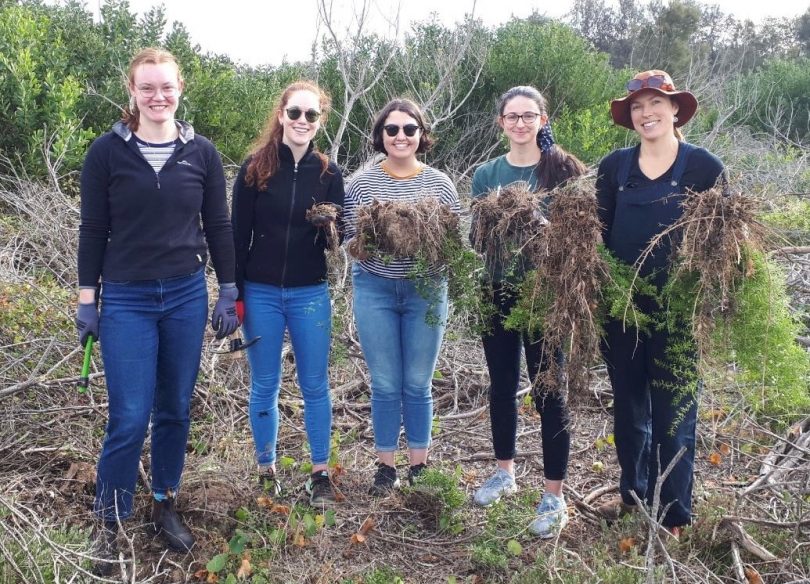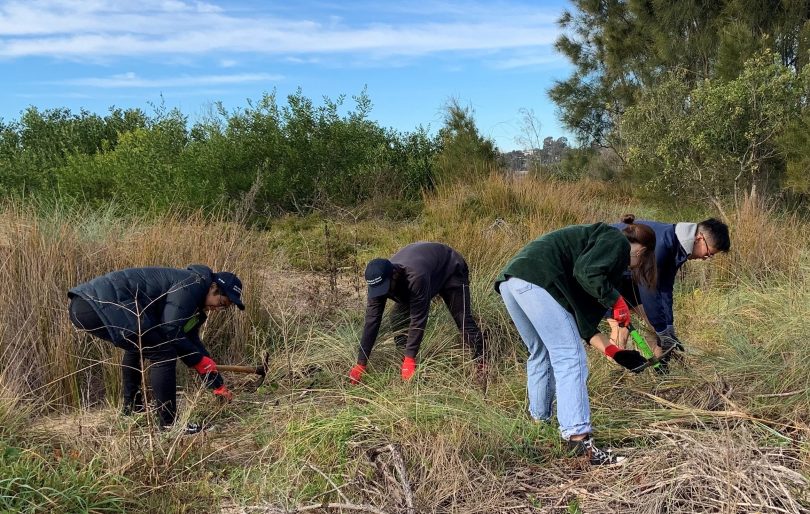
Local GP and ANU rural clinical school lecturer Dr Michelle Hamrosi (right) removing weeds in the dunes with the ANU Medical students. Photo: Michelle Hamrosi.
What do weeds and ANU medical students have in common? They are both popping up everywhere.
However, unlike weeds, the medical students are very welcome visitors to the Eurobodalla.
As part of ANU Rural Week, a group of students from the ANU medical school recently swapped scrubs and masks for boots and gardening gloves, scalpels and stethoscopes for picks and trowels.
ANU Rural Week brings first year medical students to rural location across SE NSW for a chance to immerse themselves into a rural community from both a medical and social perspective.
The aim is to give the students some insight into life as a rural doctor and entice them to choose a rural stream in their later years of study.
The ANU Rural Clinical School offers a range of placement opportunities for ANU medical students to complete part of their training in the ANU’s regional nodes in Young/Cowra, Goulburn, Batemans Bay/Moruya, Cooma, and Bega.
One of the planned activities for this year’s Rural Weeks took place in an outdoor classroom in the sand dunes of Corrigans Beach, Batemans Bay.
The pockets of coastal dunes opposite the Toll Gate Islands near Hanging Rock are being gradually restored by a concerted effort of volunteers and council workers.
Led by local GP and ANU rural clinical school lecturer Dr Michelle Hamrosi, the group of students spent a crisp, winter morning learning about the impact of bushfires, degradation and weeds on the local environment.
Eurobodalla Shire Council’s invasive species coordinator Paul Martin showed the students how to identify various weeds such as the marram grass, bridal creeper and asparagus fern, and also how to effectively remove them.
“The dune system at Corrigans Beach has been subject to significant disturbance in the past but with some help from volunteers like the ANU medical students, we’re confident that we can restore the area to a more natural state complete with the values and ecosystem services that a natural coastal sand dune landscape offers,” Mr Martin explained.
“This includes more native birds and invertebrates, beautiful scenic amenity, recreational opportunities and of course greater resilience with respect to rising sea levels and retention of our ever-diminishing urban coastal environments.”
The vision for this area is to restore it to a more natural state with plant species that are indicative of a pre-1750 coastal dune landscape.

The vision for this area is to restore it to a more natural pre-1750 coastal dune landscape. Photo: Michelle Hamrosi.
The ANU team was set to work mainly targeting marram grass (Ammophila arenaria), which is a transformative weed in the Eurobodalla dune landscape. It is a clumping perennial grass, originally imported from Europe to provide erosion control after disturbance such as sand mining and recovery of inappropriate beach access tracks.
“Unfortunately, this grass completely changes the dune environment by displacing native sand binding plants such as hairy spinifex (Spinifex serecius), which exacerbates coastal erosion due to its clumping nature, forming big scarps where it falls into the ocean during storm events,” Mr Martin said.
Dr Hamrosi said the ANU Rural Clinical School in Batemans Bay hopes to continue to foster a relationship between visiting students and local ongoing environment projects.
“As a medical professional, we understand the bigger picture of our health and how we are all fundamentally connected to the natural environment around us. Our health depends on clean water, clean air, rich biodiversity and a stable climate. All of these are currently at threat through human activity and climate change,” Dr Hamrosi said.
“We all need to play our part in restoring balance – even medical students.
“Med students and Landcare may not seem like a natural pairing, but our health and environment are intrinsically linked. Doctors and students from across the country are coming together in organisations such as Doctors for the Environment Australia, and increasingly raising the alarm about the health risks of the climate crisis,” Dr Hamrosi said.
Dr Hamrosi said there are important added benefits to being involved in these sort of regenerative activities.
“We also get exercise, sunshine, social connection as well as a sense of achievement and purpose. This is all incredibly important, especially after the devastating impacts of the bushfires on our local environment and our mental health.”
“You don’t have to be a doctor to pitch in. Landcare groups across the shire give are a great way to get hands-on in protecting our environment.”
For more information on volunteering visit Eurobodalla Landcare

Eurobodalla Shire Council invasive species coordinator Paul Martin (centre) showed the students how to identify various weeds and how to effectively remove them. Photo: Michelle Hamrosi.



